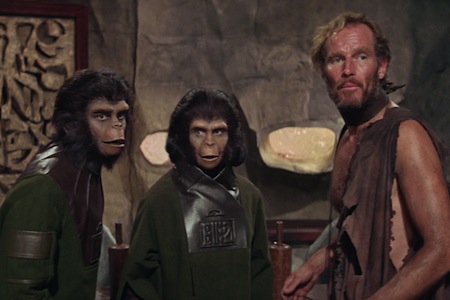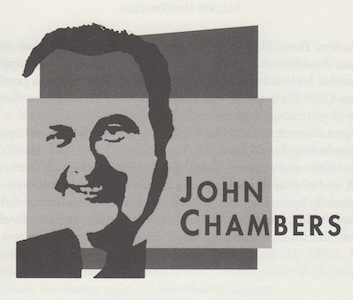Born: September 12, 1922, Chicago, IL
Died: August 25, 2001, Woodland Hills, CA
You can actually read emotion through those animal faces.
—Charlton Heston
Before entering the film industry, John Chambers was an army dental technician, specializing in prosthetics for wounded soldiers. In 1953, he applied his knowledge in NBC’s makeup rooms, where his most memorable creations were the pointy ears of Mr. Spock for television’s Star Trek series.
Editor’s note: The essays of Scott Smith’s 1998 book, The Film 100, are being republished in their entirety here on Keyframe, not so much as the last word on cinema, but as a starting point for further discussion. Please join the conversation. To view the entire Film 100 list and find links to all the essays, please visit Reintroducing the Film 100. Additionally, note that John Chambers’ role in history has been viewed differently since the release of Argo in 2012.
In 1967, Chambers was approached by producer Arthur Jacobs, who was itching to make a sci-fi fantasy movie that would rival the excitement of King Kong. Jacobs had acquired a screenplay by Twilight Zone creator Rod Serling, based on a Pierre Boulle novel about a world inhabited by a race of intellectually advanced simians, and secured Charlton Heston as the lead. While pitching the idea to Darryl and Richard Zanuck at 20th Century Fox, Jacobs sensed their reluctance to take a chance on a monkey movie. Fox wanted to see proof that Planet of the Apes was a plausible idea.
So Jacobs arranged for a sneak preview. He commissioned Chambers to make a prototype mask. In a brief test, Chambers put an ape face on veteran actor Edward G. Robinson, who ran lines with Heston in a five-minute filmed rehearsal. After screening the test, Fox decided to gamble $5 million that Chambers’s makeup could be accepted on a realistic level.
With six months to prepare, and $1 million allotted for materials, Chambers went to work. More than a thousand extras would need to be turned into simians. Chambers left that job to his associate, Dan Striekpeke, who created masks that pulled snugly over the head.
Masks wouldn’t do for the main actors, they were claustrophobic and rigid, restricting movement and making the actors look stiff and expressionless. Chambers needed a solution that would allow for the subtleties of fine acting, unhampered by the makeup. After all, Jacobs had recruited a stellar field of actors (Robinson, who was exhausted by the long makeup sessions in the test, turned down a role, as would Orson Welles, who was offered General Ursus). After experimenting with a variety of substances, he settled on a rubbery material called latex, which Lon Chaney had frequently incorporated into his monsters’ faces. Latex had been used sporadically in makeup effects throughout the history of Hollywood, but generally it was regarded as too difficult to apply to the human face. Besides, most actors would need to look consistent over months of shooting; latex was too coarse and unruly for predictable results every time.
Chambers called all of the principal actors to his workshop and made several molds of each actor’s face with plaster of Paris. Then, he created plaster busts and poured small amounts of latex over them to arrive at a thin skin. He punctured the skin with tiny pores, so his masks would breathe as actors perspired under them, and developed special makeup paint that allowed him to detail the latex skins without closing the pores in the foam rubber. Another Chambers innovation was custom-made, nonirritating adhesives that kept the latex firmly fastened to the skin. These developments were especially important, considering that many actors would be in their costumes for up to fourteen hours at a time. The latex skin was applied in sessions that lasted as long as eight hours. The finished creation was a talking ape that, when photographed in extreme close-up, showed audiences details and subtleties previously unseen.
The debut of Planet of the Apes (1968) was an unqualified success, reaping $15 million in domestic receipts. It generated four sequels and millions of dollars for Fox. Chambers received an Oscar and repeated his performance in Beneath the Planet of the Apes (1970), this time using latex to display the effects of radiation on a race of telepathic mutants. Other actors who donned the monkey makeup in the series included Claude Akins, John Huston and Paul Williams. Historian Michael Druxman said of the film, “The real star is makeup artist John Chambers, whose contribution to [the movie]—more than any other single factor—was responsible for the motion picture’s success.”
Chambers may well deserve credit for saving the horror film genre. After a period of fantastic drive-in movies, film trends were shifting toward realism. Horror film directors, working with low budgets and cheap effects, had to keep their cameras at a distance and simply couldn’t produce the thrills that captivate audiences. Chambers’ latex revolution brought movie monsters closer to the camera than ever before. Suddenly, fantasy filmmakers were introducing us to terrifying new faces, and sometimes taking us right down into their throats. Chambers would go on to apply his innovations to other films, including Steven Spielberg’s Jaws (1975), and the realism of his makeup accomplishments has extended to everything from Mask (1985) to Mrs. Doubtfire (1993).
To read all the republished articles from ‘The Film 100,’ go to Reintroducing the Film 100 here on Keyframe.





